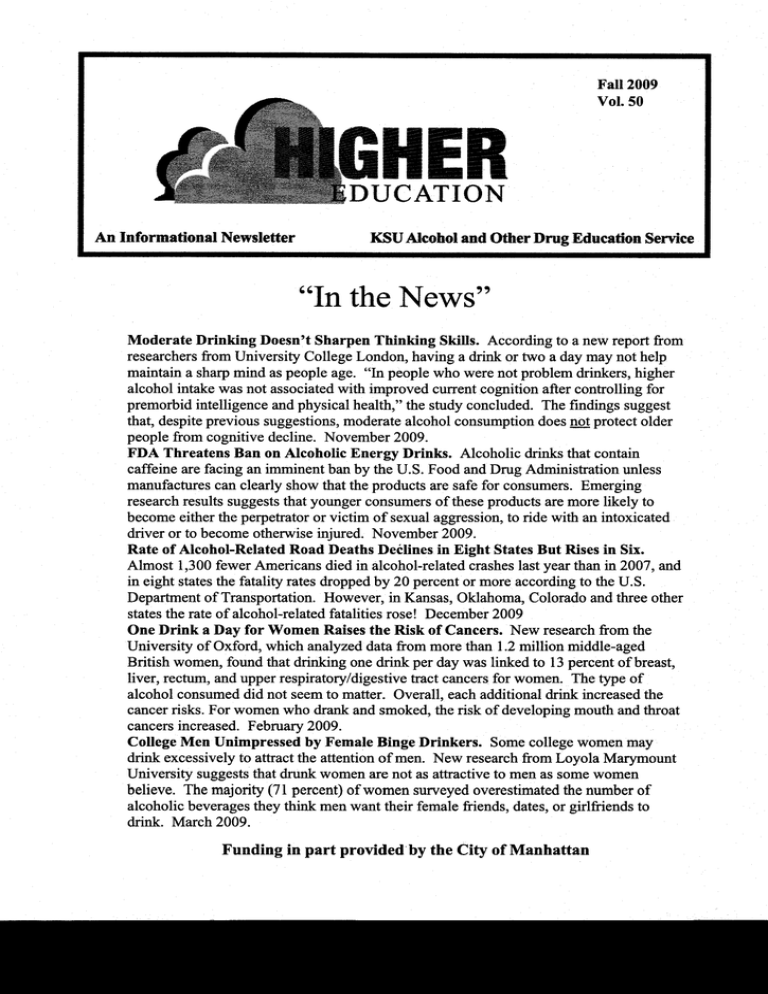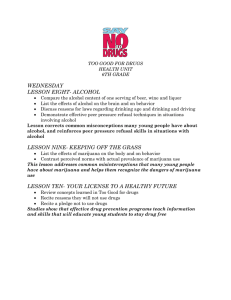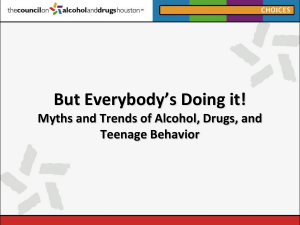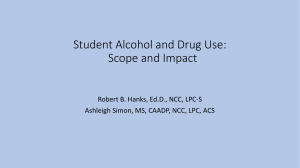
Falt 2009
Vol.50
ffiHffi
NUCATION
An Informafional Newslsttsr
K$UAlcohol snd Oth*r llrug Sduc*fion$rrvicc
"In the News"
Moderate Drinking Doesn't Sharpen Thinking Skilts. According to a new report from
researchersfrom University College London, having a drink or two aday may not help
maintain a sharpmind as people age. "In people who were not problem drinkers, higher
alcohol intake was not associatedwith improved current cognition after controlling for
premorbid intelligence and physical health," the study concluded. The findings suggest
that, despiteprevious suggestions,moderatealcohol consumptiondoesnot protect older
people from cognitive decline. November 2009.
FDA Threatens Ban on Alcoholic Energy Drinks. Alcoholic drinks that contain
caffeine are facing an imminent ban by the U.S. Food and Drug Administration unless
manufacturescan clearly show that the products are safe for consumers. Emerging
researchresults suggeststhat younger consumersof theseproducts are more likely to
become either the perpetratoror victim of sexual aggression,to ride with an intoxicated
driver or to becomeotherwise injured. November 2009.
Rate of Alcohol-Related Road Deaths Declines in Eight States But Rises in Six.
Almost 1,300 fewer Americans died in alcohol-relatedcrasheslast year than in 2007, and
in eight statesthe fatality rates droppedby 20 percent or more accordingto the U.S.
Departmentof Transportation. However, in Kansas,Oklahoma, Colorado and three other
statesthe rate of alcohol-relatedfatalities rose! December2009
One Drink a Day for Women Raises the Risk of Cancers. New researchfrom the
University of Oxford, which analyzeddata from more than 1.2 million middle-aged
British women, found that drinking one drink per day was linked to 13 percent of breast,
liver, rectum, and upper respiratory/digestivetract cancersfor women. The type of
alcohol consumeddid not seemto matter. Overall, each additional drink increasedthe
cancerrisks. For women who drank and smoked,the risk of developing mouth and throat
cancersincreased. February 2009.
College Men Unimpressed by Female Binge Drinkers. Somecollege women may
drink excessivelyto attract the attention of rnen. New researchfrom Loyola Marymount
University suggeststhat drunk women are not as attractive to men as somewomen
believe. The majority (7L percent) of women surveyedoverestimatedthe number of
alcoholic beveragesthey think men want their female friends, dates,or girlfriends to
drink. March 2009.
Funding in part provided by the City of Manhaffan
Horrific Van Crash Highlights Disturbing Trend in Female DUIs. More women in
the U. S. are drinking and driving. The AssociatedPressreportedthat while most drunk
driversare men, the numberof DUI arrestsof women rose28.8 percentbetween1998
and2007,while amongmen, sucharrestsdeclined7.5 percent. The National Highway
Traffic Safety Administration reportsthat there are of parts of the country where women
are now the majority of impaired drivers involved in fatal crashes.August 2009.
Drunk Drivers with Kids in Car Could Face Feloniesin New York. The New York
StateAssemblyhaspasseda bill that makesit a felony offenseto drive while intoxicated
if children under age 16 are in the vehicle. Currently, only Arizonamakesit a felony
offenseto drive drunk with children. The bill alsorequiresfirst-time convicteddrunk
driversto install ignition-interlockdeviceson their carsto preventrepeatoffenses.New
York GovernorDavid Pattersonsupportsthe bill. November 2009.
Alcoholics Have a Hard rime ProcessingEmotions. Brain damagecausedby
excessivedrinking can impair an alcoholic'sability to readfacial expressionsand also
bluntshis or her emotions. The study,conductedat the University of California at San
Diego, indicatedthat this problem could result in miscommunicationduring emotionally
chargedsituationsand could leadto unnecessaryconflicts and difficulties in interpersonal
relationships.The resultingnegativerepercussions
can,in turn, contributeto increased
drinking. August 2009.
Truck CrashesHave DecreasedSignificantly After Alcohol Testing Required. There
havebeen23 percentfewer alcohol-relatedtruck crashesper mile in the U.S. sincethe
requirementbecameeffectivethat commercialtruck drivers submitto alcoholtesting.
The U.S. law calls for suspendingthe licenseof any commercialtruckerfound to have a
blood-alcohollevel of 0.04 percentor higher. October 2009.
Painkiller Misuse Up Among Young Adults. A study from the SubstanceAbuse and
Mental Health ServicesAdministrationsaysthat prescriptionpainkiller misuseamong
young adultshas increasedevenas non-medicaluse by teenagersdecreased
between
2002 and2007. Overall,about5.2 million peopleagesl2 yearsand older said that
within the pastmonth they had usedprescriptionpain relieversnon-medically.
February2009.
10 Percent of Americans Use Antidepressants. New researchfinds that27 million
Americanstook antidepressant
medicationsin 2005, doublethe numberwho reported
taking such drugs in 1996. Researchersat Columbia University and the University of
Pennsylvaniaalso found that fewer patientswere seekingpsychotherapyfor depression,
eventhoughresearchhas shownthat therapycan be at leastas effectiveas medicationin
treating depression. August 2009.
RoadsideDriver Checks Reveal Less Drinking, but More Evidence of Drug Use.
Random testsof U.S. drivers revealedthat fewer Americans are driving drunk, but more
have tracesof illicit drugsin their bodies. In its study of blood, breathand salivatests
collectedon weekendsfrom drivers in 300 locationsnationally,the National Highway
Traffic SafetyAdministration(NHTSA) found thatjust 2.2percentof drivershad bloodalcohollevelsin excessof the legal limit of 0.08 percent. Most impairmentwas detected
betweenthe hours of 1 a.m. and 3 a.m. Motorcyclistsand pick-up truck driverswere
more likely to be intoxicatedthan drivers of other vehicles. NHTSA also found that nine
percentof drivershad detectabletracesof marijuana,andfour percenthad cocaineor
prescriptiondrugsin their system. July 2009.
Kansas AlcohollDrug Costs. In 2005 in Kansas,underagedrinking costswere
estimatedat $646 million dollars. Kansasspendsa little over 17 percent of its state
budget on substanceabuseprevention and addiction. Fall 2009.
Coltege Students More Likely to Misuse the Drug Adderal. According to data from
the National Survey on Drug Use and Health, college studentsbetweenthe agesof 18 and
22were twice as likely to use the amphetaminedrug Adderall non-medically as those
who had not been in college at all or were part-time students. Approximately 90 percent
of the full-time college studentswho had used Adderall non-medically in the past year
also engagedin binge drinking in the past month. Thesestudentswere three times more
likely to use marijuana, eight times more likely to use cocaine,and five times more likely
to use pain relievers for non-medical purposes. April 2009.
Average THC in Marijuana Tops 10 Percent. An annual govemment study of
marijuana potency found that the averageTHC content in streetsamplestopped 10
percent for the frst time last year; in 1983,marijuana averagedfour percent THC. A
researcherat the University of Mississippi predicted that the averageTHC level of
marijuana would continue to rise for severalmore yearsbefore leveling off at 15-16
percent. May 2009.
Link Found Between Marijuana Use and Testicular Cancer. Researchers
say that
young men who smoke marijuana weekly, or who have smokedbeginning in their teen
years, face twice the risk of an aggressiveform of testicular cancercalled nonseminona.
Current marijuana usershad an overall 70-percentincreasedrisk of testicular cancer
comparedto nonusers. The testicles are one of the few organsin the body that have
receptor sites for cannabinoids,the active ingredient in marijuana. February 2009.
MaIe Sexual Problems Caused by Marijuana Use. Researchfrom the University of
Melbourne found that men who smoke marijuana may have more problems achieving
orgasm during sex than abstainers. Previous studieshave also found a relationship
between marijuana use and male sexual dysfunction. The Australian researchalso found
that men and women who smoked marijuana daily were more likely to have had multiple
sex parfirersthan nonusers. September2009.
Army No Longer Considering Recruits Who Fail Drug Tests. A few yearsago the
U.S. Army relaxed its rules to admit somerecruits who failed drug teststo join the
service. Now that the economy has worsenedand the situation inlraq is quieter,
recruiting is picking up and the Army is eliminating the waiver. Likewise, the Army has
discontinuedthe practice of allowing some recruits with felony recordsto apply for
waivers. The Army will no longer acceptrecruits with Juvenile a:rest recordsunlessthey
have completedtheir high schooldiplomas. April2009.
Family l)inners Still Popular in U.S. Homes. More than 60 percent of families in the
U.S. said they ate family dinners together at least five nights during the past week.
Researchat Columbia University's National Center on Addiction and SubstanceAbuse
has found that there are many benefits to frequent family dinners, including that the more
often kids eat dinner with their families, the less likely they are to smoke, drink or use
drugs. November 2009.
Male Athletes Drink More, Smoke Less, Adolescent maleswho play team sportsare
less likely to smoke cigarettesor be depressedbut are more likely to drink alcohol and
get into fights. The study of 13,000U.S. high school studentsalso found that male
athleteshad binge-drinking rates40 percenthigher than nonathletes. November 2009.
Athletes Who Use Performance Drugs Likely to Abuse Other Substances.Rutgers
University researchers
have found that studentathleteswho uselegal drugsand illicit
drugsto boosttheir sportsperformancealso aremore likely to drink heavily and use
recreationaldrugs like marijuana and cocaine. The study also found that the drug-using
athleteswere more likely to suffer consequences
suchas missingclass,getting into
fights, and eamingpoor grades.November2009.
Flu and Smoking. Studiesby the Centersfor DiseaseControl and Preventionof
smokersversusnon-smokersshow a higher mortality rate from influenza for smokers.
Peopleexposedto secondhandsmoke areat greaterrisk from flu complications,the study
determined.November2009.
Unemployed Americans Smoke the Most. More than45 percentof unemployed
Americansages18 to 64 smokecigarettescomparedto 28 percentof thoseemployed,
accordingto findings from a surveyof 74,000peopleby the SubstanceAbuse and Mental
Health ServicesAdministration. October 2009.
Cigarette CompaniesUse Color to Convey 'Mild' Message. Federallaw will soonbar
cigarettecompaniesfrom using termslike 'mild' and 'light' to describetheir products,
but marketersareusing pastelsand other soft color schemeson the cigarettepackagingto
conveythe mild/light impression.Pall Mall Lights, for example,arenow calledPall
Mall Blues and are offeredin a royal-bluepackage.Researchin countriessimilar to the
U.S. finds that smokersbelievethat cigarettessold undernameslike "silver," "gold" and
"smooth" are saferthan other labelsand lessaddictive. October2009.
One in Five PreventableDeaths Causedby Smoking. According to the Harvard
Schoolof Public Health,smoking-relateddiseasescauseaboutone out of every five
preventabledeathsin the United States. May 2009. The World Health Organizationsays
that at leastfive million peopledie from smokingeachyear.December2009.
RESOURCES
KSU Counseling Services
English/CounselingServicesBldg.
Phone:532-6927
KSU Alcohol & Other Drug
Education Service
Director: BillArck
2 l4 English/CounselingServicesBldg.
Phone:532-6921
AlcoholicsAnonymous
Noon Meeting (Mon.-Sat.)
Blue Valley United Methodist Church
835 ChurchAve.
Phone: 531-9260
Higher Educationis a publication of the KSU Alcohol and Other Drug
Education Service,English/CounselingServicesBldg., KansasStateUdversity, Manhattan,KS 66506. ('185)532-6927.An equal opportunity employer.
Director:Bill Arck, M.S.; AssistantDirector:GeorgetteMiller, L.M.S.W.
Alcohol and Other Drug Education Service
214 EnglishlCounseling ServicesBldg.
Kansas StateUniversity
Manhattan,KS 66506-6503
(78s)s32-6927
The intent of Higher Education is to provide
accurate, timely infomation represenling the
cunent state of alcohol/dtug l,zowledge. Keep in
mind lhat researchon thesematters continues daily
and is subject to change. It is our intention to keep
you informed, not to diagnose or treat illness. For
personal alcohol and other drug problems, please
consult your physician or counselor
We send "Higher Education" newsletter to a cross section of faculty and staff in KSU departments with labels generated
through lfuman Resourcesin Edwards Hall. If a newsletter is addressedto someoneno longer employed in your department,
please forward it to someoneelsewho did not receive one. Thanks!






